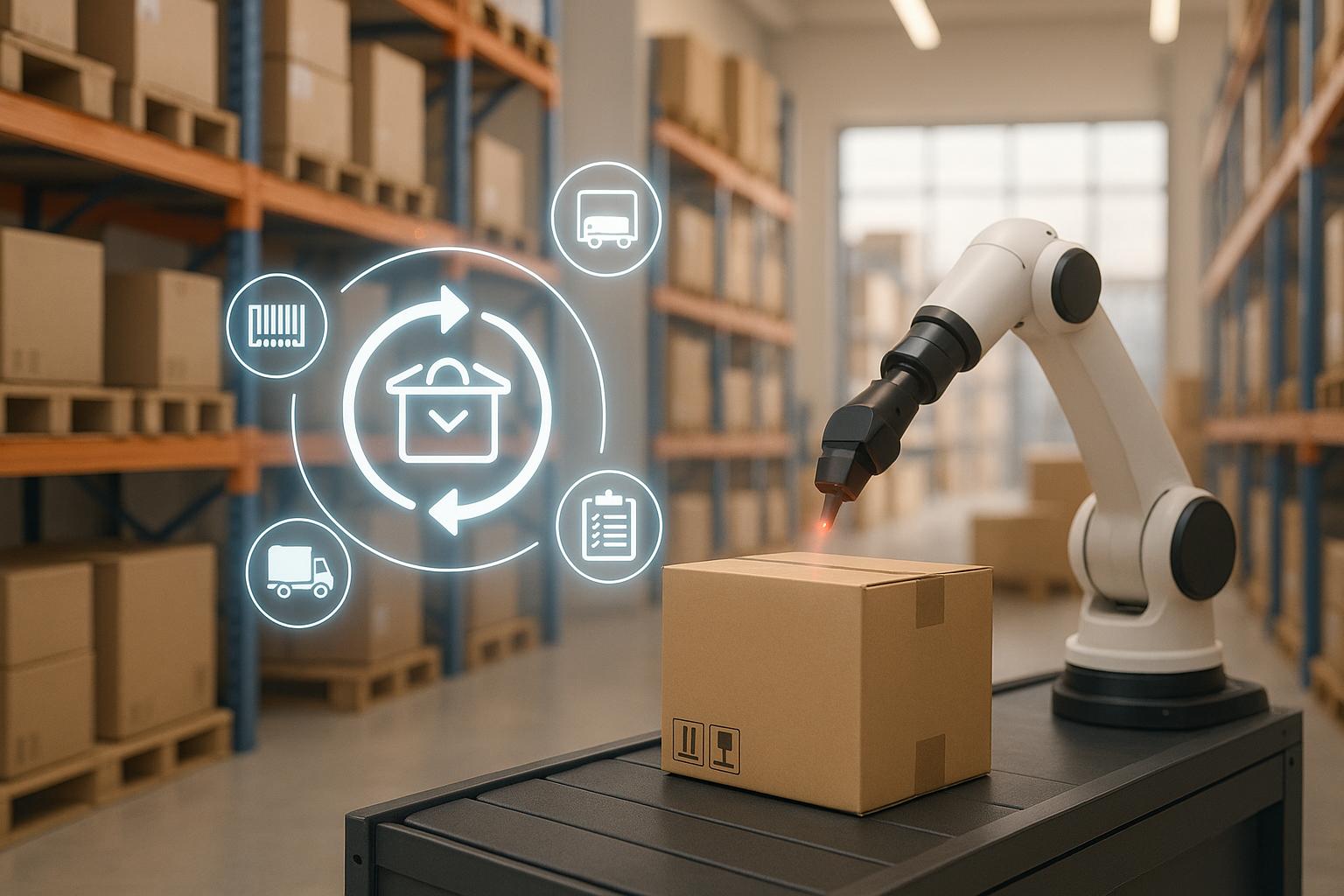Ultimate Guide to Predictive Analytics in Logistics

Predictive analytics is transforming logistics by helping businesses anticipate challenges, improve efficiency, and meet customer demands. It uses historical data, AI, and machine learning to forecast trends, optimize operations, and reduce costs. Here's what you need to know:
- Demand Forecasting: Predict future inventory needs using sales data, seasonal trends, and external factors like weather.
- Route Optimization: Enhance delivery accuracy by analyzing traffic, weather, and GPS data to create efficient routes.
- Fleet Maintenance: Schedule repairs proactively using sensor data, minimizing downtime and extending equipment life.
- Key Tools: Machine learning frameworks (e.g., TensorFlow, PyTorch), BI platforms (e.g., Power BI), Transportation Management Systems (TMS), and IoT devices.
Predictive analytics benefits logistics providers by improving resource allocation, reducing errors, and enhancing customer satisfaction. While challenges like data quality and system integration exist, starting small, prioritizing training, and ensuring executive support can lead to success.
What Is Predictive Analytics In Logistics & Supply Chain? - Smart Logistics Network
How Predictive Analytics Works in Logistics
Predictive analytics plays a key role in streamlining logistics operations, improving efficiency, and meeting customer expectations. It is particularly impactful in three core areas that directly influence supply chain performance.
Demand Forecasting
Demand forecasting is one of the standout uses of predictive analytics in logistics. Instead of relying solely on historical averages, predictive models analyze a variety of data sources to accurately anticipate future inventory needs.
Using machine learning, these models uncover patterns that might go unnoticed through manual analysis. They process historical sales data, seasonal trends, market conditions, and external factors like weather changes and promotional campaigns. For example, a model could identify that certain products see increased demand not only during specific seasons but also during particular weather events.
This precision helps businesses maintain the right inventory levels, avoiding both overstocking and stockouts. Predictive analytics also supports dynamic inventory management, allowing companies to adapt reorder points based on expected demand shifts. This means businesses can keep inventories lean while ensuring products are available across all channels.
The benefits don’t stop at inventory management - predictive analytics also reshapes delivery planning.
Route Optimization and Delivery Accuracy
Route optimization powered by predictive analytics revolutionizes how deliveries are planned and transportation networks are managed. Traditional methods often rely on static maps and simple distance calculations, but predictive analytics takes it a step further by factoring in real-time variables.
By analyzing live traffic updates, weather forecasts, GPS data, and historical delivery trends, predictive models create optimized routes that improve delivery performance. For instance, if heavy traffic is anticipated on a route, the system can recommend an alternative path before delays occur. Similarly, when adverse weather conditions are forecasted, shipments can be rerouted to ensure timely delivery.
This proactive approach not only helps meet customer expectations for reliable service but also allows for quick adjustments when unexpected disruptions arise. Dynamic routing ensures minimal delays and keeps deliveries on schedule, even when conditions change at the last minute.
Predictive analytics doesn’t just improve delivery routes - it also plays a critical role in keeping fleets operational.
Fleet Maintenance and Downtime Reduction
Predictive maintenance leverages real-time data to schedule repairs before problems arise. Instead of waiting for equipment failures or sticking to rigid maintenance schedules, predictive analytics determines exactly when maintenance is necessary.
The system evaluates sensor data, maintenance records, and equipment usage history to identify early warning signs of potential issues. For example, sensors track metrics like engine temperature, oil pressure, and brake wear. Machine learning algorithms then analyze this data to detect subtle changes that might indicate an impending failure.
This approach reduces the risk of unexpected breakdowns and costly emergency repairs. By scheduling maintenance during planned downtime, companies can avoid the high costs of roadside fixes and minimize delivery disruptions.
Additionally, predictive maintenance programs extend the lifespan of fleet equipment by addressing issues before they escalate. For companies managing large fleets, this translates into fewer service interruptions, lower repair costs, and more vehicles available for revenue-generating activities. The result is a more efficient operation with less time lost to repairs.
Tools and Technologies for Predictive Analytics in Logistics
To make predictive analytics work in logistics, having the right tools and technology is non-negotiable. Third-party logistics (3PL) providers need systems that process data efficiently, deliver accurate forecasts, and integrate seamlessly into daily operations. These tools range from machine learning frameworks to transportation management systems (TMS) and IoT devices that provide real-time updates.
Machine Learning Frameworks and Analytics Platforms
Machine learning frameworks are the driving force behind predictive analytics, allowing logistics companies to create custom models that learn from past data and predict future outcomes. Popular frameworks like TensorFlow, Scikit-learn, and PyTorch each bring unique strengths to the table.
- TensorFlow is perfect for handling complex neural networks and deep learning tasks. For example, it can be used to create demand forecasting models that juggle multiple variables, such as seasonal trends and shipping routes.
- Scikit-learn offers an accessible starting point for companies new to predictive analytics. It provides pre-built algorithms suited for common logistics problems, like optimizing routes or managing inventory.
- PyTorch is ideal for experimenting and testing different approaches quickly, making it a favorite for research-focused teams.
But machine learning frameworks don’t work in isolation. Business intelligence (BI) platforms like Tableau, Power BI, and Qlik transform raw predictions into actionable insights through interactive dashboards. Picture a 3PL provider using Power BI to map out delivery performance across the country, spotting trends that lead to better route planning.
Together, these tools allow companies to analyze massive amounts of historical and real-time data, uncover patterns, and make informed decisions. For instance, JIT Transportation could use TensorFlow to predict shipment delays by analyzing weather, traffic, and historical trends, then visualize these insights in Power BI to share with their operations team.
To make these insights even more practical, TMS solutions bring predictive analytics directly into day-to-day logistics workflows.
Transportation Management Systems (TMS) with Predictive Features
Predictive TMS solutions take the insights from machine learning and BI tools and turn them into actionable plans for logistics operations. These systems analyze historical data, real-time traffic updates, and weather forecasts to recommend the best delivery schedules and routes.
These systems are designed to handle multiple variables at once, from carrier capacity and fuel costs to potential disruptions like accidents or severe weather. If something unexpected happens, the system recalculates routes instantly and updates customers with revised delivery times.
For 3PL providers, the advantages are clear. Predictive TMS can anticipate capacity issues during busy seasons, helping companies secure additional resources ahead of time. Real-time alerts keep operations teams informed about potential disruptions, enabling them to adjust plans and communicate proactively with customers.
Integration is another key strength. TMS platforms often connect seamlessly with Warehouse Management Systems (WMS) and Enterprise Resource Planning (ERP) systems, creating a unified data flow. This integration ensures that predictive models have access to up-to-date information on inventory, orders, and transportation, leading to more precise forecasts.
For a company like JIT Transportation, a predictive TMS could automate load planning across its distribution centers, foresee capacity challenges during peak times, and provide customers with accurate delivery windows based on real-time data.
IoT and Real-Time Data Integration
IoT devices and sensors play a crucial role in gathering the real-time data needed for effective predictive analytics. These devices monitor everything from vehicle locations and cargo conditions to equipment performance and environmental factors.
- GPS tracking systems provide precise location information, enabling accurate delivery time predictions and smarter route planning.
- Temperature sensors in refrigerated trucks ensure that cargo stays within safe conditions, sending alerts if there’s a risk of spoilage.
- Vibration sensors detect rough handling or equipment issues, while fuel sensors monitor consumption to optimize maintenance schedules and reduce costs.
The real power of IoT lies in its ability to provide up-to-the-minute data, keeping predictive models accurate and relevant. Unlike traditional analytics, which often rely on historical data, IoT devices enable logistics teams to react quickly to changing conditions.
Data integration platforms tie it all together, combining IoT data with other business information to create rich datasets for analysis. Predictive analytics thrives on this diversity of data - shipment records, GPS updates, sensor readings, inventory levels, customer orders, weather forecasts, and traffic patterns all come together to produce more reliable forecasts.
Beyond improving operations, real-time data integration enhances customer satisfaction. Companies can offer more accurate delivery predictions and communicate proactively about potential delays. This ability to address issues before they escalate gives logistics providers a competitive edge.
For JIT Transportation, incorporating IoT into its fleet and warehouses could enable predictive vehicle maintenance, real-time shipment tracking, and better management of temperature-sensitive goods, reinforcing its reputation for dependable and efficient supply chain solutions.
sbb-itb-eafa320
Benefits of Predictive Analytics for 3PL Providers
Predictive analytics takes 3PL providers from simply reacting to issues to proactively managing operations. This shift enhances how resources are used, boosts service reliability, and cuts costs.
Better Resource Allocation
Predictive analytics revolutionizes how 3PL providers manage their assets. By analyzing historical shipping data, seasonal trends, and real-time demand, it ensures resources are deployed exactly where they're needed.
Vehicle utilization sees a major boost when predictive models forecast demand by route and region. Instead of trucks sitting idle in one area while others face shortages, fleets can be strategically redistributed, cutting unnecessary mileage and increasing revenue per vehicle.
Warehouse operations also become more streamlined. Predictive tools forecast product movement, helping allocate storage space and staff more effectively. This is especially useful during peak seasons, allowing companies to secure extra warehouse space and workers well in advance.
Staff scheduling is another area that benefits. Predictive insights help align workforce levels with workload fluctuations, reducing overtime costs and improving productivity.
For example, JIT Transportation uses predictive analytics to strategically position resources across its nationwide network. This not only cuts costs but also improves delivery performance, directly enhancing customer satisfaction.
Improved Customer Satisfaction
Optimized resources pave the way for a better customer experience. Predictive analytics helps 3PL providers offer services that are more reliable, transparent, and tailored to customer needs.
Delivery accuracy improves as predictive models factor in variables like traffic, weather, and historical data. Customers receive realistic delivery windows, and providers can adjust schedules to minimize disruptions.
Real-time visibility becomes even more powerful when combined with predictive insights. Customers don’t just see where their shipment is - they also know when it’s likely to arrive. This added transparency helps customers plan better and builds trust.
Service consistency is elevated as predictive analytics identifies potential issues before they occur. Whether it’s addressing recurring bottlenecks or preparing for seasonal spikes, providers can ensure smooth operations and consistently exceed customer expectations.
"In logistics, consistency is everything - and that's exactly what JIT delivers. Their transportation services are dependable, seamless, and backed by a team that truly understands our business needs. Working with JIT has made a tangible difference in our efficiency and customer satisfaction."
– Armando Otiz, Manager 3pl/Inventory, Exclusive Networks
Cost Reduction and Risk Management
Predictive analytics not only trims operational costs but also helps 3PL providers manage risks before they escalate into major problems.
Operational cost savings come from identifying inefficiencies that might otherwise go unnoticed. Predictive models optimize fuel usage, improve route planning, and streamline workforce scheduling - small adjustments that add up to significant savings.
Maintenance costs drop as predictive analytics forecasts equipment failures ahead of time. Scheduled maintenance during planned downtime avoids costly emergency repairs, extending the lifespan of vehicles and equipment.
Risk mitigation is another major advantage. Predictive tools anticipate disruptions like bad weather, traffic delays, or capacity shortages, allowing companies to prepare contingency plans rather than scrambling to react. Better risk management also improves safety and cargo handling, which can lead to lower insurance premiums and reduced liability.
The benefits compound over time: greater efficiency leads to happier customers, which fuels business growth and further investment in predictive capabilities. In today’s competitive market, predictive analytics isn’t just a tool for improvement - it’s a key driver of sustainable growth and profitability for 3PL providers.
Challenges and Best Practices in Implementation
While predictive analytics offers undeniable advantages, successfully implementing it comes with its own set of challenges. Anticipating these obstacles and applying proven strategies can mean the difference between a game-changing improvement and a costly misstep.
Common Implementation Challenges
One of the biggest hurdles is data quality issues. Predictive models rely heavily on accurate, consistent, and accessible data. When shipment data is incomplete, stored across disconnected systems, or riddled with inconsistencies, the results can be disastrous. For instance, poor data can lead to flawed demand forecasts or inefficient route optimizations, causing overstocking, stockouts, or delivery delays. These issues not only disrupt operations but can also erode trust with customers.
Another significant challenge is the lack of technical expertise. Implementing predictive analytics requires specialized skills, from selecting the right tools to deploying and maintaining them. Many organizations struggle to find or develop the necessary talent to manage these advanced systems effectively.
Resistance to change often poses a less obvious but equally impactful challenge. Employees accustomed to traditional methods may distrust or resist new workflows, especially if they feel unprepared or uninformed. Without proper change management, even the most data-driven insights can go unused, undermining the initiative.
Integration with legacy systems is another roadblock. Many logistics companies still rely on older software for transportation management, warehouse operations, or enterprise planning. These systems weren’t designed with modern analytics in mind, and connecting them often requires expensive custom solutions and extended timelines.
Finally, the financial investment can be intimidating. Costs for software, infrastructure upgrades, training, and system integration can add up quickly. Without clear projections for return on investment (ROI) and strong leadership support, these projects risk delays or outright cancellation when budgets tighten.
Addressing these challenges is essential for laying the groundwork for successful implementation.
Best Practices for Success
To overcome these challenges, organizations should focus on strategies that deliver both immediate results and long-term benefits.
One effective approach is to start with focused pilot projects. Instead of diving headfirst into a full-scale rollout, begin with a specific use case that has measurable goals. For example, you might focus on improving delivery accuracy on a particular route or optimizing inventory for seasonal products. This method minimizes risk, allows teams to learn through small-scale tests, and provides tangible results that can help secure broader organizational support.
Take the example of Atlantic Health. Between 2020 and 2023, the company used predictive analytics to analyze labor costs and forecast hospital productivity. By starting small, they saved $70 million over three years and gained the expertise needed for broader applications.
Another key best practice is to prioritize data quality. Establishing data governance policies and investing in data cleaning and integration can make a world of difference. Standardizing data formats across systems and automating data collection wherever possible ensures that your models are working with reliable inputs. Regular audits can also catch and fix quality issues before they impact performance.
Investing in staff training is equally important. This includes technical training for IT teams as well as practical sessions for operational staff who will use the insights daily. Clear communication about the benefits of predictive analytics, paired with hands-on training, can ease resistance and help teams embrace the new tools.
Strong leadership is critical, so it’s essential to secure executive sponsorship. Having leadership on board ensures alignment with business objectives, breaks down data silos, and helps drive the cultural shifts needed for success.
Partnering with experts can also accelerate the process. Collaborate with experienced 3PL providers like JIT Transportation, which uses advanced predictive analytics to streamline operations. Their technology platforms, scalable infrastructure, and expertise can help companies implement predictive tools more efficiently while avoiding common pitfalls.
Finally, continuously monitor and refine your models. Predictive analytics isn’t a one-and-done solution. Models need regular updates, performance checks, and adjustments to stay relevant as business conditions evolve. Establishing review cycles ensures that your analytics remain accurate and effective.
Treating predictive analytics as a gradual transformation rather than a one-time project is key. Companies that focus on data quality, invest in their teams, and take incremental steps are far more likely to see the 20–50% reduction in supply chain errors that AI-driven forecasting can achieve.
Conclusion and Key Takeaways
Predictive analytics is transforming logistics by shifting operations from reactive problem-solving to proactive decision-making. By turning raw data into actionable insights, businesses can better allocate resources, enhance customer satisfaction, and reduce costs.
Take Atlantic Health, for example - they saved $70 million by improving labor forecasting. Or consider military logistics, which significantly reduced downtime by addressing equipment issues before they occurred. These examples highlight how predictive analytics can create measurable value across different sectors of logistics.
For 3PL providers like JIT Transportation, predictive analytics offers tools to streamline operations. It helps optimize routes, refine demand forecasting, and improve services like pick-and-pack or kitting and assembly. These improvements not only enhance reliability and consistency for customers but also enable more competitive pricing and lower operational costs.
Businesses that effectively use predictive analytics are already seeing gains in efficiency by forecasting demand, optimizing routes, and scheduling predictive maintenance. However, to maximize these benefits, companies need a well-thought-out strategy. This includes investing in high-quality data, piloting focused projects, and training teams to leverage AI-driven forecasting tools. Data quality is critical - without clean and consistent data, even the best algorithms will fall short.
The integration of IoT-driven real-time data further strengthens logistics. It allows for immediate adjustments, dynamic route optimization, and better anticipation of demand changes, all while reducing inventory costs and mitigating disruptions. When paired with machine learning, this technology becomes a powerful tool for staying ahead of potential challenges.
As logistics continues to evolve, companies that adopt predictive analytics now will be better positioned to tackle future challenges. Whether it’s managing transportation networks, streamlining warehouse operations, or handling complex supply chains, predictive analytics provides the insights needed to stay competitive and deliver exceptional service. The real question isn’t whether to implement predictive analytics - it’s how soon you can start.
FAQs
How does predictive analytics enhance demand forecasting and inventory management in logistics?
Predictive analytics empowers logistics companies to fine-tune demand forecasting. By examining historical data, market trends, and external influences, businesses can better anticipate customer needs. This proactive approach helps streamline supply chain operations, cutting down the chances of overstocking or running out of stock.
When it comes to inventory management, predictive analytics offers valuable insights into maintaining ideal stock levels, determining reorder points, and preparing for seasonal demand shifts. Using these insights, companies can lower carrying costs, enhance order fulfillment, and keep goods moving efficiently across the supply chain.
What challenges do logistics providers face when adopting predictive analytics, and how can they address them?
Implementing predictive analytics in logistics comes with its fair share of hurdles, such as ensuring data quality, integrating with existing systems, and finding the right expertise. Let’s break these down:
First, data quality is a critical factor. Inaccurate or incomplete data can throw predictions off course. That’s why it’s essential to work with clean, consistent, and well-structured data. Investing in advanced tools and adopting solid data management practices can make a big difference here.
Next, there’s the challenge of integrating predictive analytics tools with legacy systems. Older systems often aren’t built to handle modern analytics solutions, making compatibility a stumbling block. One approach is to prioritize tools that fit seamlessly with your current setup. Alternatively, a phased upgrade strategy can help ease the transition without causing major disruptions.
Finally, the lack of in-house expertise can slow things down. Predictive analytics requires skilled professionals who understand both the technology and the logistics industry. Companies can address this by hiring experienced analysts or collaborating with external specialists to guide the process and provide training.
By tackling these challenges head-on, logistics providers can tap into the full potential of predictive analytics - boosting efficiency, cutting costs, and delivering a better experience for their customers.
How do IoT devices and real-time data integration improve predictive analytics in logistics?
IoT devices are transforming predictive analytics in logistics by delivering real-time data straight from sensors, GPS trackers, and other connected tools. This steady stream of information allows logistics companies to keep a close eye on fleet performance, track shipments in transit, and gain a clearer view of supply chain operations.
With this data at their fingertips, predictive models can pinpoint potential delays, suggest more efficient routes, and even flag upcoming maintenance needs. The result? Less downtime, more efficient operations, and a smoother experience for customers.
Related Blog Posts
Related Articles

3PL Returns Handling: Step-by-Step Guide

How 3PLs Use Software for Reverse Logistics

